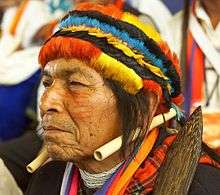Icaro
Icaro (Quechua: ikaro) is a South American indigenous colloquialism for magic song.[1] Today, this term is commonly used to describe the medicine songs performed in vegetal ceremonies, especially by shamans in ayahuasca ceremonies to induce a profound state of healing, awareness or amazement.[2][3][4] It is also commonly used to describe a traditional artisanal pattern of the Shipibo tribe based on the visions induced by ayahuasca.
Etymology
The word icaro is believed to derive from the Quechua verb ikaray, which means "to blow smoke in order to heal".[4]
In healing ceremonies
Medicine songs

Icaro is most commonly used to describe the medicine songs used by shamans in healing ceremonies, such as with the psychedelic brew ayahuasca. Traditionally, these songs can be performed by whistling, singing with the voice or vocables, or playing an instrument such as the didgeridoo or flute, and usually involve a mastery of advanced techniques to evoke the healing effects.
Traditionally, icaros may come to a shaman during a ceremony, be passed down from previous lineages of healers, or come to a shaman during a 'dieta' where plant spirits are believed to teach icaros to the shaman directly. The singing or whistling of icaros is sometimes accompanied by a chakapa, a rattle of bundled leaves.[5] Due to the complexity of certain performance techniques, it may take many years to learn certain icaros, and experienced shamans may be able to recite hundreds of them.[6]
An extended article on icaros, by Francesco Sammarco - originally published on issue 68 of Sacred Hoop Magazine (in 2010) - is available for free download from this link here.
Other healing practices
The word icaro may be used for other ritual actions taken by a healer during a ceremony for the sake of affecting consciousness.
In ayahuasca ceremonies of Iquitos, Peru, you may find any of the following are considered an icaro:
- Shaking a chakapa at a consistent tempo
- Shaking a chakapa in different corners of the room
- Blowing mapacho smoke
- Mouth-made sound effects of wind or fast-moving air
- Purging sounds and mannerisms
- Invitations of spirits or forces
- Hypnotic speaking
References
- Nicole., Maxwell (1990-01-01). Witch doctor's apprentice : hunting for medicinal plants in the Amazon. MJF Books. ISBN 1567313035. OCLC 42683849.
- Pratt, Christina (2007). Ency of Shamanism. The Rosen Publishing Group. p. 220.
- Luna, Luis Eduardo (1986). Vegetalismo (Stockholm Studies in Comparative Religion). Almqvist & Wiksell Internat. ISBN 91-22-00819-5.
- Haule, John Ryan (2011). Jung in the 21st Century: Synchronicity and science. Taylor & Francis. pp. 47–48.
- Beyer, Stephan V. (2009). Singing to the Plants: A Guide to Mestizo Shamanism in the Upper Amazon. Albuquerque: University of New Mexico Press. ISBN 978-0-8263-4729-9.
some songs, such as calling in the spirit of ayahuasca at the start of a ceremony, are performed without rhythmic accompaniment, while healings are all performed with the shacapa.
- Rozendal, Keith. "Meet Mother Ayahuasca". Retrieved 21 August 2012.